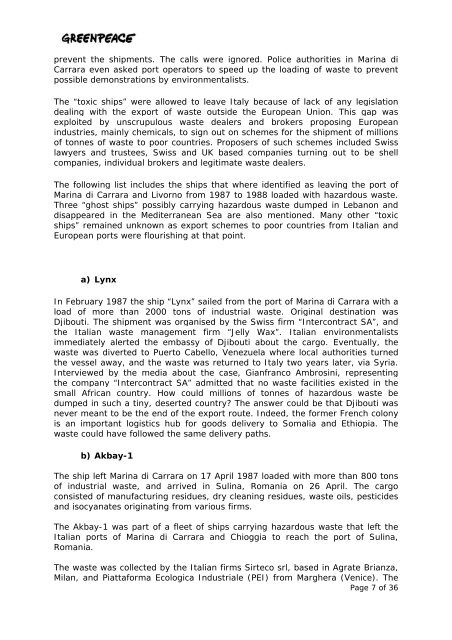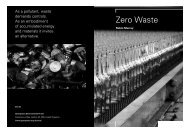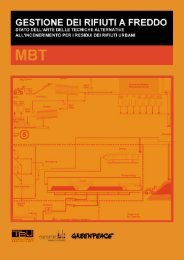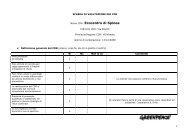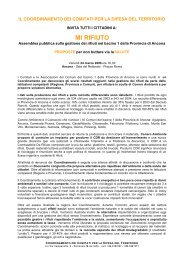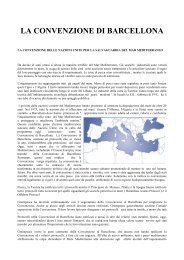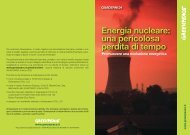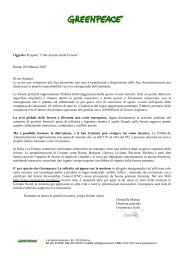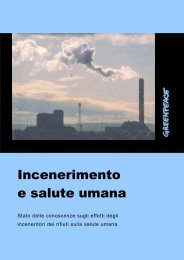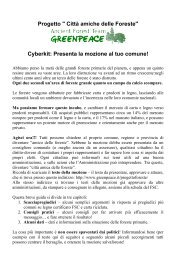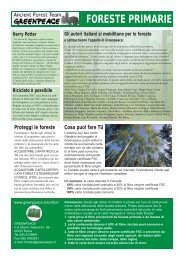The toxic ships
The toxic ships
The toxic ships
Create successful ePaper yourself
Turn your PDF publications into a flip-book with our unique Google optimized e-Paper software.
prevent the shipments. <strong>The</strong> calls were ignored. Police authorities in Marina di<br />
Carrara even asked port operators to speed up the loading of waste to prevent<br />
possible demonstrations by environmentalists.<br />
<strong>The</strong> “<strong>toxic</strong> <strong>ships</strong>” were allowed to leave Italy because of lack of any legislation<br />
dealing with the export of waste outside the European Union. This gap was<br />
exploited by unscrupulous waste dealers and brokers proposing European<br />
industries, mainly chemicals, to sign out on schemes for the shipment of millions<br />
of tonnes of waste to poor countries. Proposers of such schemes included Swiss<br />
lawyers and trustees, Swiss and UK based companies turning out to be shell<br />
companies, individual brokers and legitimate waste dealers.<br />
<strong>The</strong> following list includes the <strong>ships</strong> that where identified as leaving the port of<br />
Marina di Carrara and Livorno from 1987 to 1988 loaded with hazardous waste.<br />
Three “ghost <strong>ships</strong>” possibly carrying hazardous waste dumped in Lebanon and<br />
disappeared in the Mediterranean Sea are also mentioned. Many other “<strong>toxic</strong><br />
<strong>ships</strong>” remained unknown as export schemes to poor countries from Italian and<br />
European ports were flourishing at that point.<br />
a) Lynx<br />
In February 1987 the ship “Lynx” sailed from the port of Marina di Carrara with a<br />
load of more than 2000 tons of industrial waste. Original destination was<br />
Djibouti. <strong>The</strong> shipment was organised by the Swiss firm “Intercontract SA”, and<br />
the Italian waste management firm “Jelly Wax”. Italian environmentalists<br />
immediately alerted the embassy of Djibouti about the cargo. Eventually, the<br />
waste was diverted to Puerto Cabello, Venezuela where local authorities turned<br />
the vessel away, and the waste was returned to Italy two years later, via Syria.<br />
Interviewed by the media about the case, Gianfranco Ambrosini, representing<br />
the company “Intercontract SA” admitted that no waste facilities existed in the<br />
small African country. How could millions of tonnes of hazardous waste be<br />
dumped in such a tiny, deserted country? <strong>The</strong> answer could be that Djibouti was<br />
never meant to be the end of the export route. Indeed, the former French colony<br />
is an important logistics hub for goods delivery to Somalia and Ethiopia. <strong>The</strong><br />
waste could have followed the same delivery paths.<br />
b) Akbay-1<br />
<strong>The</strong> ship left Marina di Carrara on 17 April 1987 loaded with more than 800 tons<br />
of industrial waste, and arrived in Sulina, Romania on 26 April. <strong>The</strong> cargo<br />
consisted of manufacturing residues, dry cleaning residues, waste oils, pesticides<br />
and isocyanates originating from various firms.<br />
<strong>The</strong> Akbay-1 was part of a fleet of <strong>ships</strong> carrying hazardous waste that left the<br />
Italian ports of Marina di Carrara and Chioggia to reach the port of Sulina,<br />
Romania.<br />
<strong>The</strong> waste was collected by the Italian firms Sirteco srl, based in Agrate Brianza,<br />
Milan, and Piattaforma Ecologica Industriale (PEI) from Marghera (Venice). <strong>The</strong><br />
Page 7 of 36


